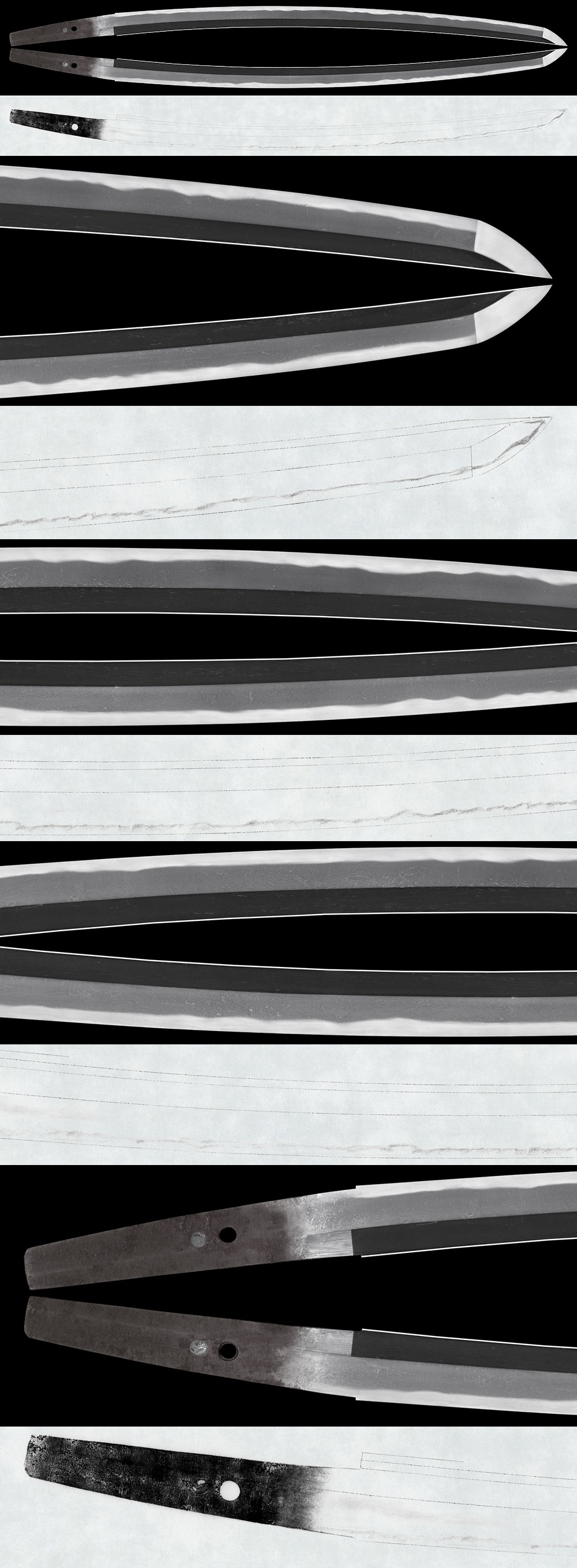Description
Dai-Sho (Matching Pair):
———————
Dai (Long Wakizashi): Wakizashi in Shirasaya with Koshirae
Signature: Mumei (attributed to Mino Senjuin)
We divide 4 sections for each sword as Saijyo Saku, Jyojyo Saku, Jyo Saku and Regular Saku.
This work is ranked as Jyo Saku, a high-grade work among those attributed to Mumei (Mino Senjuin).
Habaki: Single-layered silver Habaki
Blade Length: 52.2 cm (20.55 in)
Curvature: 1.5 cm (0.59 in)
Mekugi Hole: 2
Width at Base (Motohaba): 2.51 cm (0.99 in)
Width at Tip: 2.04 cm (0.80 in)
Thickness of Rim (Kasane): 0.59 cm (0.23 in)
Era: Mid-Muromachi period
Shape:The blade has standard width, moderate thickness, deep curvature, and a slightly extended kissaki, giving it a well-balanced appearance.
Jigane:Well-forged itame-hada with ji-nie and some flowing masame patterns.
The shinogi-ji also displays strong masame flowing through the itame.
Hamon:Nie-deki with ko-gunome midare, showing active ashi and mixed with ha.
Boshi:Notare with rounded tip, ending in hakikake.
Features:Based on the jigane, hamon, and boshi with hakikake at the tip, this blade is attributed to the Mino Senjuin school.
Koshirae:
Tsuba: Vertical oval shakudo polished tsuba with shakudo rim.
Fuchikashira: Shakudo nanako-ji with carved aoi leaves.
Saya: Black glossy lacquer saya. The kojiri is silver, carved with wave patterns, and features six plovers (chidori) inlaid with shell at the end—an elegant design.
Menuki: Large shakudo base with raised designs of autumn plants and a mantis, decorated with gold iroe (colored metal inlay).
———————
Sho (Short Wakizashi): Wakizashi in Shirasaya with Koshirae
Signature: Mumei (Shinto – Mino)
We divide 4 sections for each sword as Saijyo Saku, Jyojyo Saku, Jyo Saku and Regular Saku.
This work is ranked as Regular Saku, a standard-grade piece among Mumei (Shinto – Mino) works.
Habaki: Plain copper
Blade Length: 43.2 cm (17.01 in)
Curvature: 1.1 cm (0.43 in)
Mekugi Hole: 1
Width at Base (Motohaba): 2.6 cm (1.02 in)
Width at Tip: 2.05 cm (0.81 in)
Thickness of Rim (Kasane): 0.6 cm (0.24 in)
Era: Around Kanbun era, Edo period (circa 1661–1673)
Shape:Standard width and thickness with moderate curvature and slightly extended kissaki.
Jigane:Ko-itame mixed with masame.
The shinogi-ji is similar.
Hamon:Ko-nie deki with gunome midare, mixed with pointed elements.
Boshi:Rounded with hakikake.
Features:Based on the jigane and hamon, this work is attributed to the Mino tradition.
Koshirae:
Tsuba: Vertical oval shakudo polished tsuba with shakudo rim.
Fuchikashira: Shakudo nanako-ji with carved aoi leaves.
Saya: Black glossy lacquer saya. The kojiri is silver, carved with waves and sprays, and inlaid with six plovers in shell—an elegant and symmetrical design on both sides.
Note: There is a flaw on the saya.
Menuki: Large shakudo base with raised autumn plant and mantis motif, decorated with gold iroe.
Kozuka: Silver base carved with patterns.
———————
Aoi Art’s Comment: These Dai-Sho have consecutive registration numbers, indicating they have been used as a pair since the Edo period.
It was common at that time to use a matching pair of wakizashi for practicality, especially when attending castle visits where long swords were cumbersome.
The saya’s elegant design is reminiscent of Hokusai’s woodblock prints.
The matching fittings (tsuba, fuchikashira, menuki) are unified in style, with the large menuki being particularly distinctive.
The fittings are well-crafted overall.
The habaki of the wakizashi shows some damage and looseness, but original daisho sets have become increasingly rare in recent years. Considering the reasonable price, we highly recommend this piece.
Aoi Art estimation paper: Whole Oshigata











 日本語
日本語








